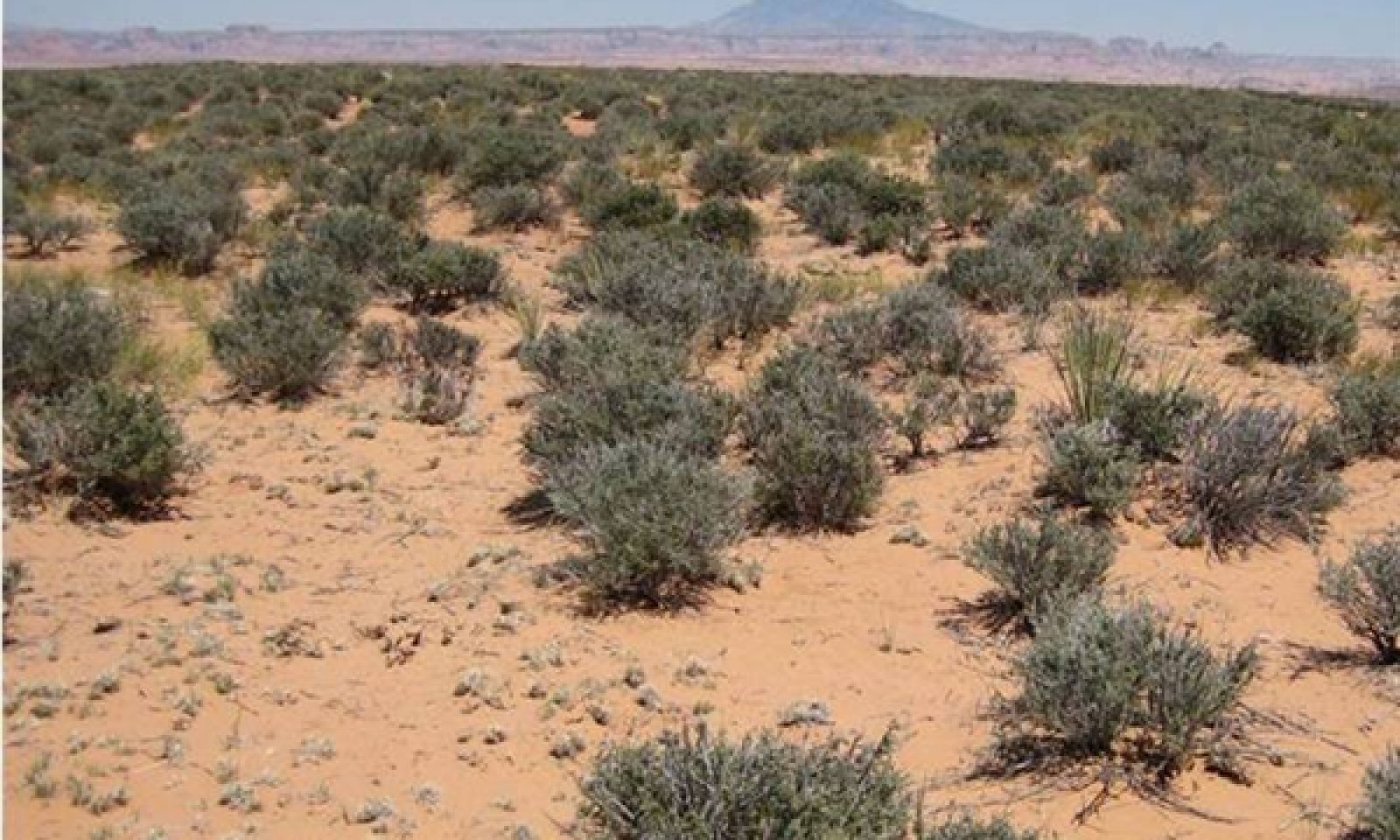

Natural Resources
Conservation Service
Ecological site R035XC373AZ
Sandy Upland 10-14" p.z. Warm
Last updated: 5/19/2025
Accessed: 12/21/2025
General information
Provisional. A provisional ecological site description has undergone quality control and quality assurance review. It contains a working state and transition model and enough information to identify the ecological site.
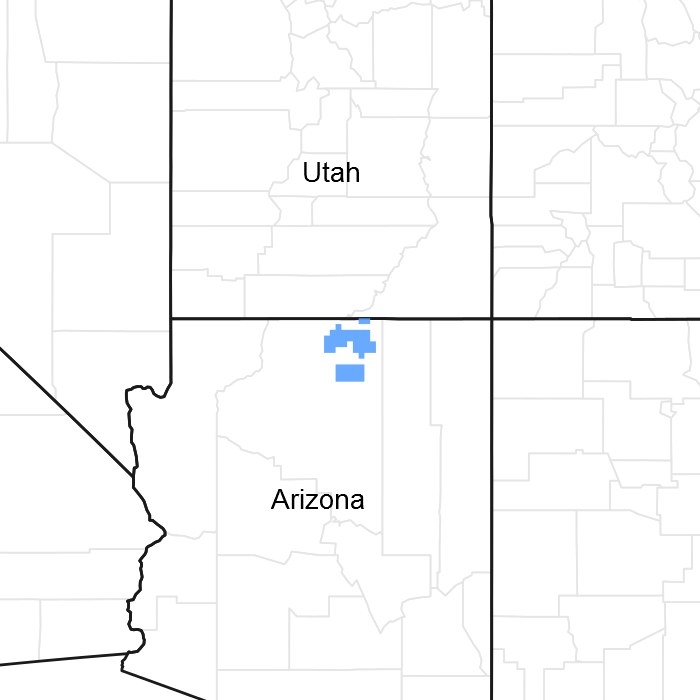
Figure 1. Mapped extent
Areas shown in blue indicate the maximum mapped extent of this ecological site. Other ecological sites likely occur within the highlighted areas. It is also possible for this ecological site to occur outside of highlighted areas if detailed soil survey has not been completed or recently updated.
MLRA notes
Major Land Resource Area (MLRA): 035X–Colorado Plateau
This ecological site is found in Common Resource Area 35.3 – the Colorado Plateau Sagebrush – Grasslands.
The Common Resource Area occurs within the Colorado Plateau Physiographic Province. It is characterized by a sequence of flat to gently dipping sedimentary rocks eroded into plateaus, valleys and deep canyons. Elevations range from 4800 to 6700 feet and precipitation averages 10 to 14 inches. The elevation range is lower (about 4500 to 6000 ) on the western side of the Colorado Plateau along the Grand Canyon, and moves up about 500 to 800 feet higher on the eastern side in the areas of the Navajo and Hopi Indian Reservations due to rain shadow effects from the Kaibab Plateau and Mogollon Rim. Common vegetation in this region includes Wyoming big sagebrush, Utah juniper, Colorado pinyon - cliffrose, Mormon tea, fourwing saltbush, blackbrush Indian ricegrass, needle and thread, western wheatgrass Galleta, black grama, blue grama, and sand dropseed. Sedimentary rock classes dominate the plateau with volcanic fields occurring for the most part near its margin. The soil temperature regime is mesic and the soil moisture regime is ustic aridic.
Ecological site concept
Soils on this site are deep to very deep. Surface textures range from fine sand to coarse loamy sand. These soils are excessively well drained with very low to low runoff. This ecological site occurs on stabilized dunes, interdunes and sand sheets in dune fields and mesa summits. This site occurs in the lower elevations and warmer south facing slopes.
Table 1. Dominant plant species
| Tree |
Not specified |
|---|---|
| Shrub |
(1) Coleogyne ramosissima |
| Herbaceous |
(1) Achnatherum hymenoides |
Physiographic features
This site occurs on stabilized dunes, interdunes and sand sheets in dune fields and mesa summits. Sand sheets occurs in interdunes, on relatively flat plateaus, or on mesa summits.
This site occurs in the lower elevations and warmer south facing slopes in the common resource area that are preferred by blackbrush.
Table 2. Representative physiographic features
| Landforms |
(1)
Sand sheet
(2) Plateau (3) Interdune |
|---|---|
| Ponding frequency | None |
| Elevation | 4,800 – 6,700 ft |
| Slope | 1 – 15% |
| Aspect | Aspect is not a significant factor |
Climatic features
Winter summer moisture ratios range from 70:30 to 60:40. Late spring is usually the driest period, and early fall moisture can be sporadic. Summer rainds fall from June through September; moisture originates in the Gulf of Mexico and creates convective, usually brief, intense thunderstorm. Cool season moisture from October through May tends to be frontal; it originates in the Pacific and the Gulf of California and falls in widespread storms with longer duration and lower intensity. Precipitation generally comes as snow from December through February. Accumulations above 12 inches are not common but can occur. Snow usually lasts for 3-4 days, but can persist much longer. Summer daytime temperatures are commonly 95 - 100 F and on occasion exceed 105 F. Winter air temperatures can regularly go below 10 F and have been recorded below - 20 F.
Table 3. Representative climatic features
| Frost-free period (average) | 168 days |
|---|---|
| Freeze-free period (average) | 193 days |
| Precipitation total (average) | 14 in |
Figure 2. Monthly precipitation range
Figure 3. Monthly average minimum and maximum temperature
Influencing water features
The soil moisture on this ecological site comes from precipitation. The site does not benefit significantly from run-on moisture. The sandy surface texture of the soil allows the site to capture the majority of both gentle winter storms and intense summer thunderstorms with little runoff.
Soil features
Soils on this site are deep to very deep. Surface textures range from fine sand to coarse loamy sand. These soils are excessively well drained with very low to low runoff. They are formed in alluvium and eolian deposits from sandstone and siltstone from Navajo sandstone and other Jurassic age formations. The upper surface horizons may be slightly or non-effervescent. Below the surface horizon, the soil becomes more effervescent with depth. Carbonate accumlations generally become strong to violently calcareous within 24" of the surface when treated with HCL acid.
Soil survey map unit components that have been correlated to this ecological site include:
SSA 707 Little Colorado River Area MU's 1 Mido, 32 Ustic haplocalcids & Mido;
SSA 711 Navajo Mountain Area MU's 10 Earlweed & Shoegame, 25 Mido (limy substratum), 26 & 43 Mido (loamy substratum), 26 Ustic hapolcalcids, 29 Mido & Pensom, 38 Earlweed.
Table 4. Representative soil features
| Parent material |
(1)
Eolian sands
–
sandstone
(2) Alluvium – siltstone |
|---|---|
| Surface texture |
(1) Fine sand (2) Sand (3) Loamy sand |
| Family particle size |
(1) Sandy |
| Drainage class | Somewhat excessively drained to excessively drained |
| Permeability class | Rapid |
| Soil depth | 40 – 80 in |
| Surface fragment cover <=3" | 2% |
| Surface fragment cover >3" | Not specified |
| Available water capacity (0-40in) |
1.5 – 5.2 in |
| Calcium carbonate equivalent (0-40in) |
15% |
| Soil reaction (1:1 water) (0-40in) |
7.4 – 8.6 |
| Subsurface fragment volume <=3" (Depth not specified) |
10% |
| Subsurface fragment volume >3" (Depth not specified) |
Not specified |
Ecological dynamics
An ecological site is not a precise assemblage of species for which the proportions are the same from place to place or from year to year. In all plant communities, variability is apparent in productivity and occurrence of individual species. Spatial boundaries of the communities; however, can be recognized by characteristic patterns of species composition, association, and community structure. The historic climax plant community for this ecological site has been described by sampling relict or relatively undisturbed sites and/or reviewing historic records. The historic climax plant community is the plant community that evolved over time with the soil forming process and long term changes in climatic conditions of the area. It is the plant community that was best adapted to the unique combination of environmental factors associated with the site.
Natural disturbances, such as drought, fire, grazing of native fauna, and insects, are inherent in the development and maintenance of these plant communities. The effects of these disturbances are part of the range of characteristics of the ecological site. Fluctuations in plant community structure and function caused by the effects of natural disturbances help establish the boundaries and characteristics of an ecological site. They are accounted for as part of the range of characteristics of the ecological site. Recognizable plant community phases are identified in the reference state of the ecological site. Some sites may have a small range of variation, while others have a large range. Some plant community phases may exist for long periods of time, while others may only occur for a couple of years after a disturbance.
Deterioration of the plant community, hydrology, or soil site stability on an ecological site can result in crossing a threshold or potentially irreversible boundary to another state, or equilibrium. This can occur as a result of the loss of soil surface through erosion, the loss of the stability of the site due to disturbances that cause active erosion on the site, increases in the amounts and/or patterns or runoff from rainstorms, changes in availability of surface and subsurface water, significant changes in plant structural and functional types, or the introduction of non-native species. When these thresholds are crossed, the potential of the ecological site to return to the historic climax plant community can be lost, or restoration will require significant inputs . There may be multiple states possible for an ecological site, determined by the type and or severity of disturbance.
The known states and transition pathways for this ecological site are described in the state and transition model. Within each state, there may be one or more known plant community phases. These community phases describe the different plant community that can be recognized and mapped across this ecological site. The state and transition model is intended to help land users recognize the current plant community on the ecological site, and the management options for improving the plant community to the desired plant community.
Plant production information in this site description is standardized to the annual production on an air-dry weight basis in near normal rainfall years.
State and transition model

Figure 4. STM - R035XC373AZ
More interactive model formats are also available.
View Interactive Models
More interactive model formats are also available.
View Interactive Models
Click on state and transition labels to scroll to the respective text
Ecosystem states
State 1 submodel, plant communities
State 2 submodel, plant communities
State 1
Reference State
The dominant aspect of this site is a low shrub canopy of blackbrush, fourwig saltbush and Mormon tea, mixed with perennial cool and warm season grasses and some forbs. Other shrubs include broom snakeweed, Greene rabbitbrush and sand sagebrush. Commonly seen grasses include Indian ricegrass, galleta, blue grama and dropseeds.
Community 1.1
Shrubland - Grasses

Figure 5. Low Elevation Site
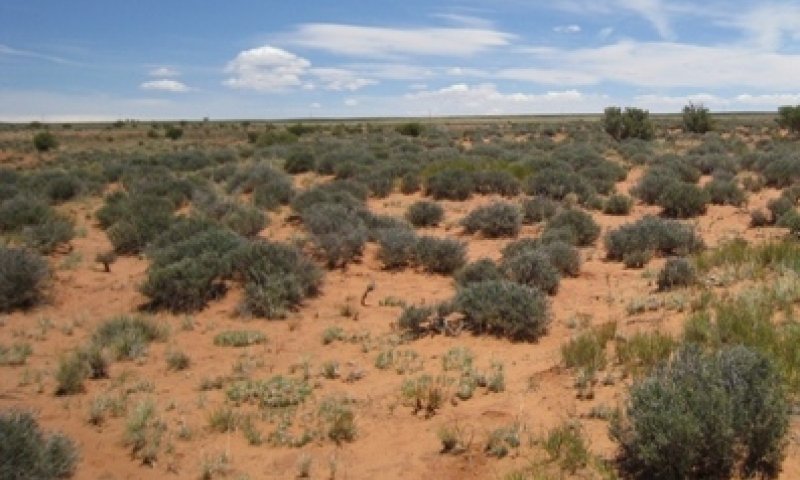
Figure 6. Higher Elevation Site

Figure 7. Mid Elevation Site
The dominant aspect of this plant community is a low shrub canopy of blackbrush, fourwing saltbush and Mormon tea, mixed with perennial cool and warm season grasses and some forbs. Other shrubs include broom snakeweed, Greene rabbitbrush and sand sagebrush. Commonly seen grasses include Indian ricegrass, galleta, blue grama and dropseeds.
Figure 8. Annual production by plant type (representative values) or group (midpoint values)
Table 5. Annual production by plant type
| Plant type | Low (lb/acre) |
Representative value (lb/acre) |
High (lb/acre) |
|---|---|---|---|
| Shrub/Vine | 180 | 280 | 380 |
| Grass/Grasslike | 65 | 100 | 135 |
| Forb | 5 | 15 | 25 |
| Tree | 0 | 5 | 10 |
| Total | 250 | 400 | 550 |
Table 6. Ground cover
| Tree foliar cover | 0% |
|---|---|
| Shrub/vine/liana foliar cover | 0% |
| Grass/grasslike foliar cover | 0% |
| Forb foliar cover | 0% |
| Non-vascular plants | 0% |
| Biological crusts | 5-30% |
| Litter | 10-20% |
| Surface fragments >0.25" and <=3" | 0-5% |
| Surface fragments >3" | 0-1% |
| Bedrock | 0% |
| Water | 0% |
| Bare ground | 40-65% |
Table 7. Soil surface cover
| Tree basal cover | 0-1% |
|---|---|
| Shrub/vine/liana basal cover | 2-8% |
| Grass/grasslike basal cover | 1-3% |
| Forb basal cover | 0-2% |
| Non-vascular plants | 0% |
| Biological crusts | 0% |
| Litter | 0% |
| Surface fragments >0.25" and <=3" | 0% |
| Surface fragments >3" | 0% |
| Bedrock | 0% |
| Water | 0% |
| Bare ground | 0% |
Table 8. Canopy structure (% cover)
| Height Above Ground (ft) | Tree | Shrub/Vine | Grass/ Grasslike |
Forb |
|---|---|---|---|---|
| <0.5 | – | 1-5% | 1-5% | 1-10% |
| >0.5 <= 1 | – | 15-25% | 1-10% | 0-5% |
| >1 <= 2 | – | 5-15% | 0-5% | – |
| >2 <= 4.5 | 0-1% | 1-5% | – | – |
| >4.5 <= 13 | 0-2% | – | – | – |
| >13 <= 40 | – | – | – | – |
| >40 <= 80 | – | – | – | – |
| >80 <= 120 | – | – | – | – |
| >120 | – | – | – | – |
Figure 9. Plant community growth curve (percent production by month). AZ3531, 35.3 10-14" p.z. all sites. Growth begins in the spring and continues through the summer..
| Jan | Feb | Mar | Apr | May | Jun | Jul | Aug | Sep | Oct | Nov | Dec |
|---|---|---|---|---|---|---|---|---|---|---|---|
| J | F | M | A | M | J | J | A | S | O | N | D |
| 0 | 1 | 3 | 17 | 18 | 10 | 19 | 20 | 10 | 1 | 1 | 0 |
Community 1.2
Blackbrush Shrubland

Figure 10. Blackbrush Shrubland
This plant community is characterized by a dense canopy of blackbrush with scattered shrubs like Mormon tea, broom snakeweed, yucca and rabbitbrush. There is a scattered understory of grasses and forbs. When surface disturbance is minimal this plant community has a moderate resistance to wind and water erosion due to high amounts of biological crust and shrub canopy.
Community 1.3
Disturbed Surface, Shrub Dominated
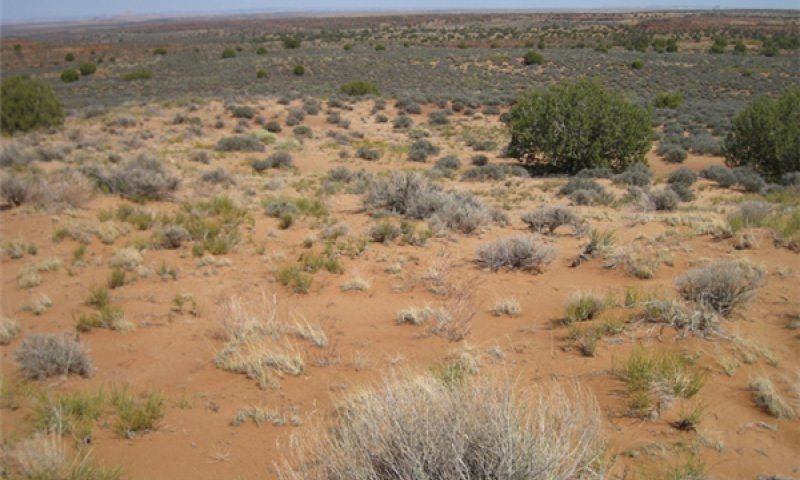
Figure 11. Disturbed Surface - Shrub Dominated
In this plant community there is a mix of shrubs and grasses along with a high percentage of bare ground. This site has a increase of blowouts and active deposition. Most blowouts are small and are stabilizing with grasses and forbs. Common shrubs include rubber rabbitbrush, sand sagebrush, Mormon tea, blackbrush, sand buckwheat, Greene rabbitbrush, snakeweed and false pillar gumweed. This plant community has a variety of grasses and forbs. Common grasses include sand dropseed, sandhill muhly, blue grama, Indian ricegrass and needle and thread.
Pathway 1.1A
Community 1.1 to 1.2


Drought, long term winter dominated moisture patters, unmanged grazing and lack of periodic fire will reduce the perennial grasses and allow woody species to increase on the site.
Pathway 1.1B
Community 1.1 to 1.3


Reduced perennial grass cover, increase bare ground/ frequent soil surface disturbance, unmanaged grazing, prolonged drought
Pathway 1.2A
Community 1.2 to 1.1


Prescribed grazing/No grazing, favorable precipitation
Pathway 1.2B
Community 1.2 to 1.3


Reduced perennial grass cover, increase bare ground/ frequent soil surface disturbance, continuous grazing, prolonged drought
Pathway 1.3B
Community 1.3 to 1.1


Prescribed grazing/No grazing, favorable precipitation
Pathway 1.3A
Community 1.3 to 1.2


Prescribed grazing/No grazing, favorable precipitation
State 2
Native/ Invasive Annuals
The dominant aspect of this site is a mix of shrubs canopy and annual forbs and grasses. Common shrubs are Mormon tea, broom snakeweed, Greene rabbitbrush, blackbrush, rubber rabbitbrush. The herbaceous canopy is dominated by annual forb, both native and non-natives.
Community 2.1
Native Shrubs with Annuals

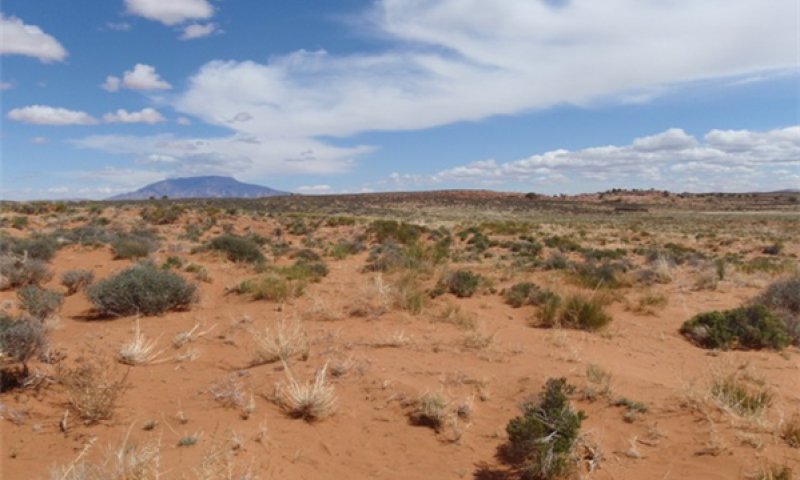
Figure 12. Shrubland with Invasive Annuals
In this phase the plant community has been changed through disturbances and invasion. The site has active soil erosion; blowouts are common and deposition is occuring around shrubs and trees, if presents. Large bare ground patches are common and connected. The vegetation is mostly comprised of scattered native shrubs along with occasional junipers and succulents. Blackbrush may or may not be present in this state. Common shrubs include rubber rabbitbrush, sand sagebrush, Mormon tea, Greene rabbitbrush, snakeweed and false pillar gumweed. Perennial grass cover has decline significantly or may be absent, while annual grasses and forbs have increased in cover. Introduced non-native annuals grasses and forbs are present and may be well established.
Transition T1A
State 1 to 2
Invasion of exotic annuals, Prolonged Drought, Continuous Heavy Grazing, Loss of Perennial Grass Cover
Restoration pathway R2A
State 2 to 1
This pathway may or not be possible, Reseeding of favorable shrubs and grasses, Prescribed grazing management/ No Grazing until grasses have established, Favorable precipitation
Additional community tables
Table 9. Community 1.1 plant community composition
| Group | Common name | Symbol | Scientific name | Annual production (lb/acre) | Foliar cover (%) | |
|---|---|---|---|---|---|---|
|
Grass/Grasslike
|
||||||
| 1 | Dominant Grasses | 60–110 | ||||
| Indian ricegrass | ACHY | Achnatherum hymenoides | 20–60 | – | ||
| blue grama | BOGR2 | Bouteloua gracilis | 5–45 | – | ||
| James' galleta | PLJA | Pleuraphis jamesii | 5–25 | – | ||
| sand dropseed | SPCR | Sporobolus cryptandrus | 2–25 | – | ||
| 2 | Other Grasses | 5–25 | ||||
| Fendler's threeawn | ARPUF | Aristida purpurea var. fendleriana | 0–10 | – | ||
| squirreltail | ELEL5 | Elymus elymoides | 0–10 | – | ||
| needle and thread | HECO26 | Hesperostipa comata | 0–10 | – | ||
| spike dropseed | SPCO4 | Sporobolus contractus | 0–10 | – | ||
| sixweeks fescue | VUOC | Vulpia octoflora | 0–5 | – | ||
| Grass, perennial | 2GP | Grass, perennial | 0–5 | – | ||
|
Forb
|
||||||
| 3 | Forbs | 5–25 | ||||
| Wright's bird's beak | COWR2 | Cordylanthus wrightii | 0–10 | – | ||
| tansyaster | MACHA | Machaeranthera | 0–10 | – | ||
| thicksepal cryptantha | CRCR3 | Cryptantha crassisepala | 0–8 | – | ||
| gooseberryleaf globemallow | SPGR2 | Sphaeralcea grossulariifolia | 0–8 | – | ||
| longbeak streptanthella | STLO4 | Streptanthella longirostris | 0–8 | – | ||
| woolly plantain | PLPA2 | Plantago patagonica | 0–6 | – | ||
| Forb, annual | 2FA | Forb, annual | 0–6 | – | ||
| Esteve's pincushion | CHST | Chaenactis stevioides | 0–6 | – | ||
| shortstem lupine | LUBR2 | Lupinus brevicaulis | 0–6 | – | ||
| Ives' phacelia | PHIV | Phacelia ivesiana | 0–4 | – | ||
| mountain misery | CHAMA | Chamaebatia | 0–4 | – | ||
| rose heath | CHER2 | Chaetopappa ericoides | 0–4 | – | ||
| buckwheat | ERIOG | Eriogonum | 0–4 | – | ||
| flatspine stickseed | LAOC3 | Lappula occidentalis | 0–4 | – | ||
| cryptantha | CRYPT | Cryptantha | 0–4 | – | ||
| bulbous springparsley | CYBU | Cymopterus bulbosus | 0–4 | – | ||
| little hogweed | POOL | Portulaca oleracea | 0–4 | – | ||
| dock | RUMEX | Rumex | 0–4 | – | ||
| annual Townsend daisy | TOAN | Townsendia annua | 0–4 | – | ||
| globemallow | SPHAE | Sphaeralcea | 0–2 | – | ||
| touristplant | DIWI2 | Dimorphocarpa wislizeni | 0–2 | – | ||
| pink funnel lily | ANBR4 | Androstephium breviflorum | 0–2 | – | ||
| milkvetch | ASTRA | Astragalus | 0–2 | – | ||
| mustard | BRASS2 | Brassica | 0–2 | – | ||
| mariposa lily | CALOC | Calochortus | 0–2 | – | ||
| sego lily | CANU3 | Calochortus nuttallii | 0–2 | – | ||
| mealy goosefoot | CHIN2 | Chenopodium incanum | 0–2 | – | ||
|
Shrub/Vine
|
||||||
| 4 | Dominant Shrubs | 150–270 | ||||
| blackbrush | CORA | Coleogyne ramosissima | 120–180 | – | ||
| fourwing saltbush | ATCA2 | Atriplex canescens | 20–60 | – | ||
| Cutler's jointfir | EPCU | Ephedra cutleri | 10–30 | – | ||
| 5 | Others Shrubs | 30–110 | ||||
| Greene's rabbitbrush | CHGR6 | Chrysothamnus greenei | 0–30 | – | ||
| yellow rabbitbrush | CHVI8 | Chrysothamnus viscidiflorus | 0–30 | – | ||
| rubber rabbitbrush | ERNAB2 | Ericameria nauseosa ssp. nauseosa var. bigelovii | 0–30 | – | ||
| broom snakeweed | GUSA2 | Gutierrezia sarothrae | 5–25 | – | ||
| sand sagebrush | ARFI2 | Artemisia filifolia | 0–20 | – | ||
| narrowleaf yucca | YUAN2 | Yucca angustissima | 0–10 | – | ||
| winterfat | KRLA2 | Krascheninnikovia lanata | 0–10 | – | ||
| Whipple cholla | CYWH | Cylindropuntia whipplei | 0–10 | – | ||
| pinkflower hedgehog cactus | ECFE | Echinocereus fendleri | 0–5 | – | ||
| Torrey's jointfir | EPTO | Ephedra torreyana | 0–5 | – | ||
| pale desert-thorn | LYPA | Lycium pallidum | 0–5 | – | ||
| grizzlybear pricklypear | OPPOE | Opuntia polyacantha var. erinacea | 0–5 | – | ||
| Stansbury cliffrose | PUST | Purshia stansburiana | 0–5 | – | ||
|
Tree
|
||||||
| 6 | Tree | 0–10 | ||||
| Utah juniper | JUOS | Juniperus osteosperma | 0–10 | – | ||
Interpretations
Animal community
This site is used for grazing by cattle, horses, sheep, and goats.
Hydrological functions
There no hydrologic features associated with this site.
Wood products
There is no potential for the production of wood products on this site.
Supporting information
Type locality
| Location 1: Coconino County, AZ | |
|---|---|
| UTM zone | N |
| UTM northing | 4072713 |
| UTM easting | 4772713 |
Other references
Updates and revisions for this ESD were conducted as part of a 2007-2012 Interagency Technical Assistance Agreement between the Bureau of Indian Affairs–Navajo Region and the NRCS-Arizona.
Contributors
Karlynn Huling
Kenneth Gishi
Larry D. Ellicott
Approval
Kendra Moseley, 5/19/2025
Rangeland health reference sheet
Interpreting Indicators of Rangeland Health is a qualitative assessment protocol used to determine ecosystem condition based on benchmark characteristics described in the Reference Sheet. A suite of 17 (or more) indicators are typically considered in an assessment. The ecological site(s) representative of an assessment location must be known prior to applying the protocol and must be verified based on soils and climate. Current plant community cannot be used to identify the ecological site.
| Author(s)/participant(s) | Kenneth Gishi |
|---|---|
| Contact for lead author | |
| Date | 03/02/2011 |
| Approved by | Kendra Moseley |
| Approval date | |
| Composition (Indicators 10 and 12) based on | Annual Production |
Indicators
-
Number and extent of rills:
None to very few expected. The sandy surface textures and excessively drained nature of the soils should preclude the presence of rills. An occasional rill may occur in areas near or adjacent to exposed bedrock where concentrated water flows and accumulates. -
Presence of water flow patterns:
A few widely scattered water flow patterns may be present. Water flow patterns on these soils are commonly less than 6 feet long, but may be longer on steeper slopes, generally occupying < 10% of the ground cover. Sites with well developed biological crust can provide additonal flow pathways for water, especially following intense storm events. -
Number and height of erosional pedestals or terracettes:
None to few. Short pedestals(1/2") can form at the base of plants along rills or water flow patterns. Terracettes are mostly absent. Sites with well developed biological crust can be mistaken for pedestals. These are natural and not considered signs of site departure. -
Bare ground from Ecological Site Description or other studies (rock, litter, lichen, moss, plant canopy are not bare ground):
30-60%. Functioning biological crust should not be counted as bare ground. Drought conditions may cause a short-term increase in bare ground. -
Number of gullies and erosion associated with gullies:
None expected. An occasional gully may occur on steeper slopes near or adjacent to exposed bedrock where concentrated water flows and accumulates. These gullies should stabilzed with perennial herbaceous cover. -
Extent of wind scoured, blowouts and/or depositional areas:
Wind scoured areas and blowouts should be stable. Some slight mounding around plant bases and small blowout areas may occur, especially during droughts, due to high wind erosion hazard of the soil. Mounding is mostly to occur around the base of long-lived perennial shrubs. -
Amount of litter movement (describe size and distance expected to travel):
Most woody litter accumulates under plant canopies and bases. Some fine litter will move a short distances (<5') and accumulate in depressions and flow paths. Other fines will be removed form the site by wind. -
Soil surface (top few mm) resistance to erosion (stability values are averages - most sites will show a range of values):
Expected average values of 3-4 under plant canopies and 2-3 in the plant interspaces. -
Soil surface structure and SOM content (include type of structure and A-horizon color and thickness):
Surface depths generally range from 3-5" with a single grain, loose structure. Color is variable depending on parent material, but generally has hues of yellowish red (5YR) or light to strong brown (7.5YR) -
Effect of community phase composition (relative proportion of different functional groups) and spatial distribution on infiltration and runoff:
A mixed canopy of shrubs and bunchgrasses along with scattered clumps of biological crust promote the greatest infiltration and least amount of runoff. Plant composition consists of about 65 percent shrubs, 25 percent grasses and 10 percent forbs. -
Presence and thickness of compaction layer (usually none; describe soil profile features which may be mistaken for compaction on this site):
None -
Functional/Structural Groups (list in order of descending dominance by above-ground annual-production or live foliar cover using symbols: >>, >, = to indicate much greater than, greater than, and equal to):
Dominant:
Evergreen shrubs (Blackbrush, Cutler's Mormon tea)Sub-dominant:
Cool-season grasses > Warm-season grasses > forbsOther:
trees and annual grassesAdditional:
-
Amount of plant mortality and decadence (include which functional groups are expected to show mortality or decadence):
All plant functional groups are adapted to survival in all but the most severe droughts. Severe winter droughts affect shrubs and cool season grass the most. Severe summer droughts affect warm season grasses the most. -
Average percent litter cover (%) and depth ( in):
-
Expected annual annual-production (this is TOTAL above-ground annual-production, not just forage annual-production):
300-400 lbs/ac in an average year -
Potential invasive (including noxious) species (native and non-native). List species which BOTH characterize degraded states and have the potential to become a dominant or co-dominant species on the ecological site if their future establishment and growth is not actively controlled by management interventions. Species that become dominant for only one to several years (e.g., short-term response to drought or wildfire) are not invasive plants. Note that unlike other indicators, we are describing what is NOT expected in the reference state for the ecological site:
Cheatgrass, red brome, Russian thistle and other introduced annual are most likley to invade this site with or without disturbance. Blackbrush, broom snakeweed, rabbitbrush and juniper are native to this site, but all have the potential to increase and invade this site with disturbance. -
Perennial plant reproductive capability:
All native perennial plants are adapted to the climate and are capable of producing seeds, stolons and rhizomes except during the most severe droughts.
Print Options
Sections
Font
Other
The Ecosystem Dynamics Interpretive Tool is an information system framework developed by the USDA-ARS Jornada Experimental Range, USDA Natural Resources Conservation Service, and New Mexico State University.
Click on box and path labels to scroll to the respective text.